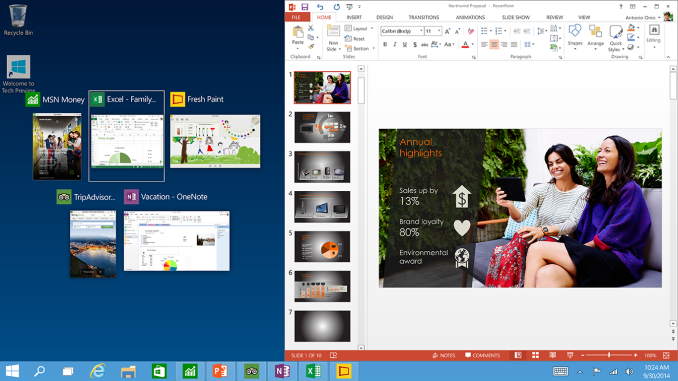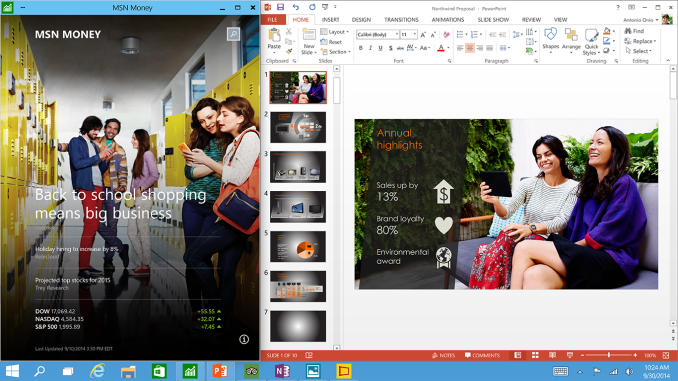Windows 10 Technical Preview First Impressions: The Return Of The Desktop
by Brett Howse on November 13, 2014 8:00 AM EST- Posted in
- Software
- Microsoft
- Windows 10
Closing Thoughts
If Windows 8 was “Touch First” then clearly Windows 10 is not. The current technical preview is very much geared towards the traditional mouse and keyboard user. This will change of course over the next several months, as the touch features get integrated back into Windows 10. As a user of all types of Windows devices, I welcome this change. It allows me to be more productive on my desktop, but still use the touch based Start Screen on a tablet or convertible notebook. Some good things have been done here to hopefully embrace the current user base, as well as new device types.
There are a number of features aimed squarely at businesses. If Microsoft wants to avoid another Windows XP with Windows 7 – where businesses do not migrate until they absolutely have to – then these features are certainly a carrot that may entice them to at least try it out. The Start Menu and other desktop additions will be great for the business users, and I think the IT crowd will be happy with a lot of the new additions around device management, identity management, and information management.
This is a technical preview of course, but still I would be remiss to not mention that it is not without its bugs. I have had a lot of issues with Windows Store apps, with many of them crashing especially when they are not the active window. Possibly there are some changes to the underlying WinRT framework for apps in standby but until we hear more about the framework changes then these problems will likely continue. More of this information should come out around the time of the next BUILD conference, scheduled for April 29th to May 1st 2015. Other issues with WinRT apps currently is that even though they can be used in a window, the absolute height of the window is limited. When Windows 8 was launched, WinRT apps were expecting to be either full screen, or snapped to the side. As such, the apps in a window must maintain a minimum height. Hopefully this can get sorted out in the future.
At first glance, Windows 10 looks like Windows 8 with a Start Menu. It is clearly a lot more than that, but even so, as someone very smart told me, that’s not a bad thing. Windows 8 had a lot going for it, but design decisions were made early on, and with a “my way or no way” attitude that it was difficult to use. It seems that Windows 10 really addresses a lot of this, while at the same time keeping and expanding on a lot of the great features that were in Windows 8 and likely overlooked due to a lot of animosity towards it.
The Windows Store is going to be a big part of this, and if the rumors of desktop apps being integrated into the store is true, then the OOBE for Windows 10 will be amazing. All of your settings and apps will now follow you from device to device, with a single log in. A lot of that is already there with Windows 8, but 10 should finish off the last remaining pieces if this is true. It makes a lot of sense, so unless the licensing terms are awful, this could be a fantastic addition to the store.
The Universal App model is also a big piece of the puzzle, but here there is more work to do. WinRT has a lot of advantages, but the framework needs to be updated at a rapid pace in order to draw developers in. It is somewhat seductive to be able to target desktops, laptops, tablets, phones, and the TV with Xbox One with a single application (with multiple interfaces of course) but until the framework is made powerful enough for more apps than just simple web front ends, it may be difficult to realize this idea. Once again, more info should be available at BUILD in regards to this.
I’ve also had some bugginess with the WinRT apps on Windows 8, which I hope will be fixed with Windows 10. At this point though, the WinRT apps are even buggier so likely there will be more pain before this is all corrected.
Although we have only seen the Technical Preview and a single update to it so far, you can see the potential for Windows 10 and what it will be able to accomplish. It is an ambitious goal to provide a single platform across such a swath of different devices, and one that was held back by the user interface before. With Continuum, it appears that it may be the best of both worlds. Even more exciting is how much more upfront and open Microsoft has been on this entire process, with not just the technical preview but also soliciting and requesting user feedback on the changes. One of the biggest change requests was a simple animation on the Start Menu, and that has already been implemented, so this really is a different world than when Windows 8 was given a sneak peek.
Due to the timing of the latest release that just came out, this article is based on the second build of Windows 10 and I have not had a chance to go over any of the changes in the latest built that arrived on November 12th.
Going forward, as we get more updates to the preview we will do our best to keep you fully informed with that the changes are, and how they will affect you. If you want to kick the tires of Windows 10 and you have not yet, just visit http://preview.windows.com and sign up for the technical preview.












198 Comments
View All Comments
Zingam - Thursday, November 13, 2014 - link
What an ugly Start menu! The old fashioned Start Menu was always a very poorly designed and retarded way to access your applications and now they've managed to do it even worse!!! I'd rather have the Windows 8.1 Start Screen.Mikemk - Thursday, November 13, 2014 - link
-12 degrees? That's coldBrett Howse - Friday, November 14, 2014 - link
Everything is relative :) I'd say anything below -20°C is uncomfortable, and -30° to -40° is cold. After -40° it's insane.JimmiG - Thursday, November 13, 2014 - link
With Start8 I could probably tolerate Windows 8.1. However the OS itself doesn't really offer anything for me over Windows 7. Sure there are a few overlooked but neat new features in Explorer and I might even gain 0.3 FPS in some game due to efficiency improvements, but that's hardly worth the cost or even the time spent for upgrading.Windows 10 would have to bring some serious improvements in addition to not blowing a 27" full-screen launcher into my face every time I want to launch Notepad or Calc.
ZenKiyoshi - Thursday, November 13, 2014 - link
How about display scaling?atlantico - Friday, November 14, 2014 - link
The return of the desktop??? The desktop was *never* gone. Idiots.loki1725 - Friday, November 14, 2014 - link
What do you use your computer for? As an engineer, nearly every piece of software I use was purchased. I paid just over $8,000 to renew the license on my Matlab software + toolboxes this morning. Between that and 3D CAD tools, you have 80% or more of my daily computer use. The rest is Office, and I'll admit I haven't used 365 much as I've always had MS Office Pro. Maybe that could be taken over. But there is still a huge need for paid 'apps' on the desktop, especially in the enterprise.croc - Friday, November 14, 2014 - link
Personally, I'd be happy with Win 10 just as it is (build 9879). Obviously there are some bumps in the road, and some things have not been thought through, but MS does seem to have listened to the sound of their customer base disappearing... (Do disappearing customers REALLY make a sound?) Win 10 is indeed built to be a desktop OS for people that have desktops, and is certainly touch capable for those that have touch interface needs. Or, that seems to be what I've read in the forums anyway, about the touchy crowd.If I were still working, I'd be crying loudly for some changes to the multiple desktop model, but plenty of people are also pointing out the issues with that model as it stands. I am sure that it will become more like the CDE versions that many Unix types have come to know and love.
Some form of aero-ing would be nice, but that is a matter of preference for some. I can live without it, it is easy enough to see which window has 'focus'.
I cannot speak to the real issues, the networking, group policy stuff etc., so I won't. But the memory model! What a joy! This OS tosses ram around like the Harlem Globetrotters on a VERY good day! As a for-instance, a game I run is Skyrim. My version is heavily modded, and in a script intensive kind of way. Load screen times are down about half just by running in Win 10 vs. Win 7. Another ram-intensive application I use a lot is 3DS Max. Re-rendering a model now takes about a third the time. I'd hate to see the performance of something like ACAD or 3DS Max written exclusively to take advantage of Win 10's memory modeling...
SirPerro - Friday, November 14, 2014 - link
There is no way Adobe and other huge software makers are going to pay Microsoft to publish the software on their store. The only chance Microsoft has is making the distribution free if they want to succeed.Otherwise it's just the same story all over again: Install windows 8.1, do not sign-up for Microsoft account, use the PC as you've always done. That's my install workflow. That will be probably my install workflow for Win 10.
asmian - Friday, November 14, 2014 - link
How easy is it to remove ALL the MS-account-related features, though? Meaning not just disable, but REMOVE.I'll never use a paid app store, or any MS email service, or the cloud in any form. I don't need weather widgets or photo editing tools that are toys compared to proper heavyweight apps I've paid for. I don't want IE or Bing search as I have better alternatives, and if I had to use calc or wordpad or other utilities I don't have free alternatives for I'd probably copy the .EXE files from Win7... So can I strip all that useless crap out and have a smaller, totally Metro app-free, non-MS-account system? That's what I need to know before I give up Win7.